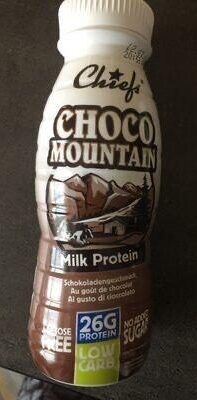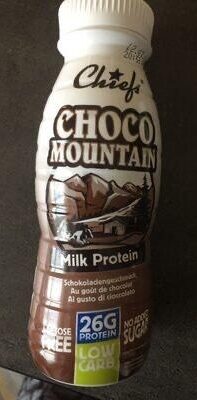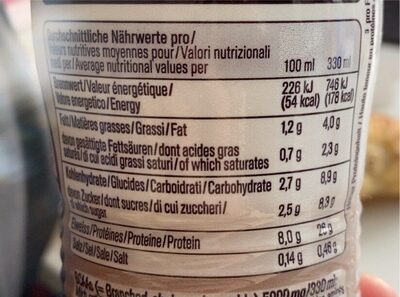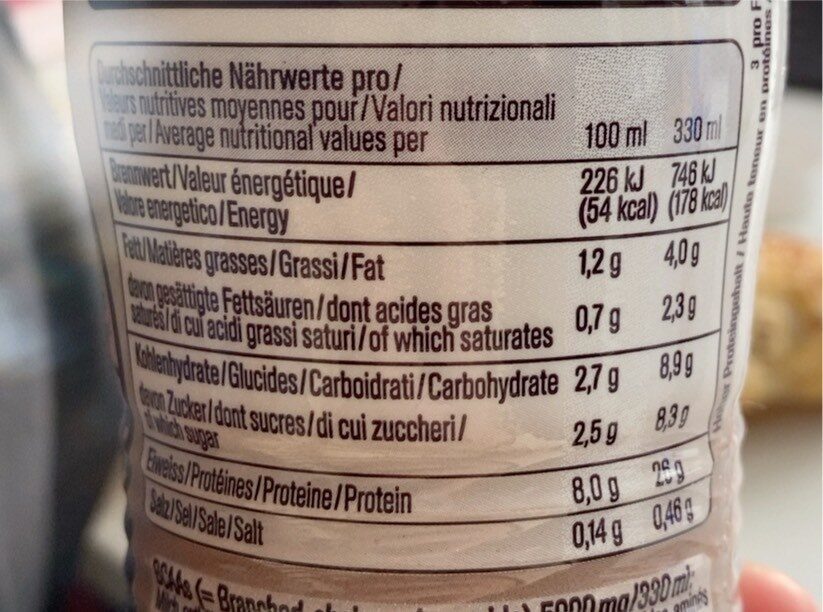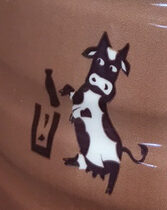Help us make food transparency the norm!
As a non-profit organization, we depend on your donations to continue informing consumers around the world about what they eat.
The food revolution starts with you!
Chiefs Choco Mountain Milk Protein - 330 ml
Chiefs Choco Mountain Milk Protein - 330 ml
Barcode: 7640151710040 (EAN / EAN-13)
Quantity: 330 ml
Packaging: Plastic, Metal, Recyclable Metals, Aluminium, Bottle, Fresh
Brands: Chiefs
Categories: Beverages, Dairies, Dairy drinks, Artificially sweetened beverages, Flavoured milks, Chocolate milks, Sweetened beverages
Labels, certifications, awards:
Sustainable farming, Green Dot, No added sugar, No colorings, No lactose, Rainforest Alliance, UTZ Certified


Origin of ingredients: Switzerland
Manufacturing or processing places: Suisse
Traceability code: CH-2425
Stores: Spar
Countries where sold: Austria, France, Switzerland
Matching with your preferences
Health
Ingredients
-
18 ingredients
German: 43% teilentrahmte Milch, Wasser, 7% Milchproteinkonzentrat, 1,7% Kakaopulver, Füllstoff: Polydextrose; Stabilisator: Mikrokristalline Cellulose; modifizierte Stärke, Aroma, Farbstoff: Zuckerkulör; Süßungsmittel: Sucralose, Acesulfam-K; Säuerungsmittel: Milchsäure; Speisesalz.Allergens: Milk, fr:proteines-lactiques
Food processing
-
Ultra processed foods
Elements that indicate the product is in the 4 - Ultra processed food and drink products group:
- Additive: E14XX - Modified Starch
- Additive: E150a - Plain caramel
- Additive: E460 - Cellulose
- Additive: E950 - Acesulfame k
- Additive: E955 - Sucralose
- Ingredient: Bulking agent
- Ingredient: Colour
- Ingredient: Flavouring
- Ingredient: Milk proteins
- Ingredient: Sweetener
Food products are classified into 4 groups according to their degree of processing:
- Unprocessed or minimally processed foods
- Processed culinary ingredients
- Processed foods
- Ultra processed foods
The determination of the group is based on the category of the product and on the ingredients it contains.
Additives
-
E1200 - Polydextrose
Polydextrose: Polydextrose is a synthetic polymer of glucose. It is a food ingredient classified as soluble fiber by the U.S. Food and Drug Administration -FDA- as well as Health Canada, as of April 2013. It is frequently used to increase the dietary fiber content of food, to replace sugar, and to reduce calories and fat content. It is a multi-purpose food ingredient synthesized from dextrose -glucose-, plus about 10 percent sorbitol and 1 percent citric acid. Its E number is E1200. The FDA approved it in 1981. It is 0.1 times as sweet as sugar.Source: Wikipedia
-
E270 - Lactic acid
Lactic acid: Lactic acid is an organic compound with the formula CH3CH-OH-COOH. In its solid state, it is white and water-soluble. In its liquid state, it is colorless. It is produced both naturally and synthetically. With a hydroxyl group adjacent to the carboxyl group, lactic acid is classified as an alpha-hydroxy acid -AHA-. In the form of its conjugate base called lactate, it plays a role in several biochemical processes. In solution, it can ionize a proton from the carboxyl group, producing the lactate ion CH3CH-OH-CO−2. Compared to acetic acid, its pKa is 1 unit less, meaning lactic acid deprotonates ten times more easily than acetic acid does. This higher acidity is the consequence of the intramolecular hydrogen bonding between the α-hydroxyl and the carboxylate group. Lactic acid is chiral, consisting of two optical isomers. One is known as L--+--lactic acid or -S--lactic acid and the other, its mirror image, is D--−--lactic acid or -R--lactic acid. A mixture of the two in equal amounts is called DL-lactic acid, or racemic lactic acid. Lactic acid is hygroscopic. DL-lactic acid is miscible with water and with ethanol above its melting point which is around 17 or 18 °C. D-lactic acid and L-lactic acid have a higher melting point. In animals, L-lactate is constantly produced from pyruvate via the enzyme lactate dehydrogenase -LDH- in a process of fermentation during normal metabolism and exercise. It does not increase in concentration until the rate of lactate production exceeds the rate of lactate removal, which is governed by a number of factors, including monocarboxylate transporters, concentration and isoform of LDH, and oxidative capacity of tissues. The concentration of blood lactate is usually 1–2 mM at rest, but can rise to over 20 mM during intense exertion and as high as 25 mM afterward. In addition to other biological roles, L-lactic acid is the primary endogenous agonist of hydroxycarboxylic acid receptor 1 -HCA1-, which is a Gi/o-coupled G protein-coupled receptor -GPCR-.In industry, lactic acid fermentation is performed by lactic acid bacteria, which convert simple carbohydrates such as glucose, sucrose, or galactose to lactic acid. These bacteria can also grow in the mouth; the acid they produce is responsible for the tooth decay known as caries. In medicine, lactate is one of the main components of lactated Ringer's solution and Hartmann's solution. These intravenous fluids consist of sodium and potassium cations along with lactate and chloride anions in solution with distilled water, generally in concentrations isotonic with human blood. It is most commonly used for fluid resuscitation after blood loss due to trauma, surgery, or burns.Source: Wikipedia
-
E460 - Cellulose
Cellulose: Cellulose is an organic compound with the formula -C6H10O5-n, a polysaccharide consisting of a linear chain of several hundred to many thousands of β-1→4- linked D-glucose units. Cellulose is an important structural component of the primary cell wall of green plants, many forms of algae and the oomycetes. Some species of bacteria secrete it to form biofilms. Cellulose is the most abundant organic polymer on Earth. The cellulose content of cotton fiber is 90%, that of wood is 40–50%, and that of dried hemp is approximately 57%.Cellulose is mainly used to produce paperboard and paper. Smaller quantities are converted into a wide variety of derivative products such as cellophane and rayon. Conversion of cellulose from energy crops into biofuels such as cellulosic ethanol is under development as a renewable fuel source. Cellulose for industrial use is mainly obtained from wood pulp and cotton.Some animals, particularly ruminants and termites, can digest cellulose with the help of symbiotic micro-organisms that live in their guts, such as Trichonympha. In human nutrition, cellulose is a non-digestible constituent of insoluble dietary fiber, acting as a hydrophilic bulking agent for feces and potentially aiding in defecation.Source: Wikipedia
-
E460i - Microcrystalline cellulose
Cellulose: Cellulose is an organic compound with the formula -C6H10O5-n, a polysaccharide consisting of a linear chain of several hundred to many thousands of β-1→4- linked D-glucose units. Cellulose is an important structural component of the primary cell wall of green plants, many forms of algae and the oomycetes. Some species of bacteria secrete it to form biofilms. Cellulose is the most abundant organic polymer on Earth. The cellulose content of cotton fiber is 90%, that of wood is 40–50%, and that of dried hemp is approximately 57%.Cellulose is mainly used to produce paperboard and paper. Smaller quantities are converted into a wide variety of derivative products such as cellophane and rayon. Conversion of cellulose from energy crops into biofuels such as cellulosic ethanol is under development as a renewable fuel source. Cellulose for industrial use is mainly obtained from wood pulp and cotton.Some animals, particularly ruminants and termites, can digest cellulose with the help of symbiotic micro-organisms that live in their guts, such as Trichonympha. In human nutrition, cellulose is a non-digestible constituent of insoluble dietary fiber, acting as a hydrophilic bulking agent for feces and potentially aiding in defecation.Source: Wikipedia
-
E950 - Acesulfame k
Acesulfame potassium: Acesulfame potassium - AY-see-SUL-faym-, also known as acesulfame K -K is the symbol for potassium- or Ace K, is a calorie-free sugar substitute -artificial sweetener- often marketed under the trade names Sunett and Sweet One. In the European Union, it is known under the E number -additive code- E950. It was discovered accidentally in 1967 by German chemist Karl Clauss at Hoechst AG -now Nutrinova-. In chemical structure, acesulfame potassium is the potassium salt of 6-methyl-1‚2,3-oxathiazine-4-3H--one 2‚2-dioxide. It is a white crystalline powder with molecular formula C4H4KNO4S and a molecular weight of 201.24 g/mol.Source: Wikipedia
-
E955 - Sucralose
Sucralose: Sucralose is an artificial sweetener and sugar substitute. The majority of ingested sucralose is not broken down by the body, so it is noncaloric. In the European Union, it is also known under the E number E955. It is produced by chlorination of sucrose. Sucralose is about 320 to 1‚000 times sweeter than sucrose, three times as sweet as both aspartame and acesulfame potassium, and twice as sweet as sodium saccharin. Evidence of benefit is lacking for long-term weight loss with some data supporting weight gain and heart disease risks.It is stable under heat and over a broad range of pH conditions. Therefore, it can be used in baking or in products that require a long shelf life. The commercial success of sucralose-based products stems from its favorable comparison to other low-calorie sweeteners in terms of taste, stability, and safety. Common brand names of sucralose-based sweeteners are Splenda, Zerocal, Sukrana, SucraPlus, Candys, Cukren, and Nevella. Canderel Yellow also contains sucralose, but the original Canderel and Green Canderel do not.Source: Wikipedia
Ingredients analysis
-
Palm oil free
No ingredients containing palm oil detected
-
Non-vegan
Non-vegan ingredients: Semi-skimmed milk, Milk proteins
-
Maybe vegetarian
Ingredients that may not be vegetarian: Flavouring
-
Details of the analysis of the ingredients
de: teilentrahmte Milch 43%, Wasser, Milchprotein 7%, Kakaopulver 1.7%, Füllstoff (Polydextrose), Stabilisator (Mikrokristalline Cellulose), modifizierte Stärke, Aroma, Farbstoff (Zuckerkulör), Süßungsmittel (Sucralose), Acesulfam-K, Säuerungsmittel (Milchsäure), Speisesalz- teilentrahmte Milch -> en:semi-skimmed-milk - vegan: no - vegetarian: yes - ciqual_proxy_food_code: 19041 - percent_min: 43 - percent: 43 - percent_max: 43
- Wasser -> en:water - vegan: yes - vegetarian: yes - ciqual_food_code: 18066 - percent_min: 34.56 - percent_max: 43
- Milchprotein -> en:milk-proteins - vegan: no - vegetarian: yes - percent_min: 7 - percent: 7 - percent_max: 7
- Kakaopulver -> en:cocoa-powder - vegan: yes - vegetarian: yes - ciqual_food_code: 18100 - percent_min: 1.7 - percent: 1.7 - percent_max: 1.7
- Füllstoff -> en:bulking-agent - percent_min: 0.588888888888889 - percent_max: 1.7
- Polydextrose -> en:e1200 - vegan: yes - vegetarian: yes - percent_min: 0.588888888888889 - percent_max: 1.7
- Stabilisator -> en:stabiliser - percent_min: 0.449999999999999 - percent_max: 1.7
- Mikrokristalline Cellulose -> en:e460i - vegan: yes - vegetarian: yes - percent_min: 0.449999999999999 - percent_max: 1.7
- modifizierte Stärke -> en:modified-starch - vegan: yes - vegetarian: yes - ciqual_proxy_food_code: 9510 - percent_min: 0.27142857142857 - percent_max: 1.7
- Aroma -> en:flavouring - vegan: maybe - vegetarian: maybe - percent_min: 0 - percent_max: 1.7
- Farbstoff -> en:colour - percent_min: 0 - percent_max: 1.7
- Zuckerkulör -> en:e150a - vegan: yes - vegetarian: yes - percent_min: 0 - percent_max: 1.7
- Süßungsmittel -> en:sweetener - percent_min: 0 - percent_max: 1.7
- Sucralose -> en:e955 - vegan: yes - vegetarian: yes - percent_min: 0 - percent_max: 1.7
- Acesulfam-K -> en:e950 - vegan: yes - vegetarian: yes - percent_min: 0 - percent_max: 1.7
- Säuerungsmittel -> en:acid - percent_min: 0 - percent_max: 1.7
- Milchsäure -> en:e270 - vegan: yes - vegetarian: yes - percent_min: 0 - percent_max: 1.7
- Speisesalz -> en:salt - vegan: yes - vegetarian: yes - ciqual_food_code: 11058 - percent_min: 0 - percent_max: 0.14
Nutrition
-
Poor nutritional quality
⚠ ️Warning: the amount of fruits, vegetables and nuts is not specified on the label, it was estimated from the list of ingredients: 0This product is considered a beverage for the calculation of the Nutri-Score.
Positive points: 4
- Proteins: 4 / 5 (value: 8, rounded value: 8)
- Fiber: 0 / 5 (value: 0.6, rounded value: 0.6)
- Fruits, vegetables, nuts, and colza/walnut/olive oils: 0 / 10 (value: 0, rounded value: 0)
Negative points: 10
- Energy: 8 / 10 (value: 226, rounded value: 226)
- Sugars: 2 / 10 (value: 2.5, rounded value: 2.5)
- Saturated fat: 0 / 10 (value: 0.7, rounded value: 0.7)
- Sodium: 0 / 10 (value: 56, rounded value: 56)
The points for proteins are counted because the negative points are less than 11.
Nutritional score: (10 - 4)
Nutri-Score:
-
Nutrient levels
-
Fat in low quantity (1.2%)
What you need to know- A high consumption of fat, especially saturated fats, can raise cholesterol, which increases the risk of heart diseases.
Recommendation: Limit the consumption of fat and saturated fat- Choose products with lower fat and saturated fat content.
-
Saturated fat in low quantity (0.7%)
What you need to know- A high consumption of fat, especially saturated fats, can raise cholesterol, which increases the risk of heart diseases.
Recommendation: Limit the consumption of fat and saturated fat- Choose products with lower fat and saturated fat content.
-
Sugars in moderate quantity (2.5%)
What you need to know- A high consumption of sugar can cause weight gain and tooth decay. It also augments the risk of type 2 diabetes and cardio-vascular diseases.
Recommendation: Limit the consumption of sugar and sugary drinks- Sugary drinks (such as sodas, fruit beverages, and fruit juices and nectars) should be limited as much as possible (no more than 1 glass a day).
- Choose products with lower sugar content and reduce the consumption of products with added sugars.
-
Salt in low quantity (0.14%)
What you need to know- A high consumption of salt (or sodium) can cause raised blood pressure, which can increase the risk of heart disease and stroke.
- Many people who have high blood pressure do not know it, as there are often no symptoms.
- Most people consume too much salt (on average 9 to 12 grams per day), around twice the recommended maximum level of intake.
Recommendation: Limit the consumption of salt and salted food- Reduce the quantity of salt used when cooking, and don't salt again at the table.
- Limit the consumption of salty snacks and choose products with lower salt content.
-
-
Nutrition facts
Nutrition facts Compared to: Chocolate milks Energy -27% Fat -35% Saturated fat -39% Carbohydrates -75% Sugars -75% Fiber +86% Proteins +132% Salt -9% Fruits‚ vegetables‚ nuts and rapeseed‚ walnut and olive oils (estimate from ingredients list analysis)
Environment
-
Eco-Score B - Low environmental impact
⚠ ️Select a country in order to include the full impact of transportation.The Eco-Score is an experimental score that summarizes the environmental impacts of food products.→ The Eco-Score was initially developped for France and it is being extended to other European countries. The Eco-Score formula is subject to change as it is regularly improved to make it more precise and better suited to each country.Life cycle analysis
-
Average impact of products of the same category: C (Score: 49/100)
Category: Chocolate flavoured milk, with sugar, partially skimmed, fortified with vitamins and chemicals elements
- PEF environmental score: 0.16 (the lower the score, the lower the impact)
- including impact on climate change: 1.38 kg CO2 eq/kg of product
Stage Impact Agriculture
56.9 %Processing
0.9 %Packaging
24.9 %Transportation
10.1 %Distribution
5.7 %Consumption
1.6 %
Bonuses and maluses
-
Origins of ingredients with a medium impact
Bonus: +5
Environmental policy: +5
Transportation: 0
Origin of the product and/or its ingredients % of ingredients Impact Switzerland 100 %Medium
-
Packaging with a medium impact
Malus: -13
Shape Material Recycling Impact Bottle Heavy aluminium Recycle Medium Unknown Plastic High ⚠ ️ The information about the packaging of this product is not sufficiently precise (exact shapes and materials of all components of the packaging).⚠ ️ For a more precise calculation of the Eco-Score, you can modify the product page and add them.
If you are the manufacturer of this product, you can send us the information with our free platform for producers.
Eco-Score for this product
-
Impact for this product: B (Score: 61/100)
Product: Chiefs Choco Mountain Milk Protein - 330 ml
Life cycle analysis score: 49
Sum of bonuses and maluses: +12
Final score: 61/100
-
Carbon footprint
-
Equal to driving 0.7 km in a petrol car
138 g CO² per 100g of product
The carbon emission figure comes from ADEME's Agribalyse database, for the category: Chocolate flavoured milk, with sugar, partially skimmed, fortified with vitamins and chemicals elements (Source: ADEME Agribalyse Database)
Stage Impact Agriculture
68.6 %Processing
0.8 %Packaging
12.9 %Transportation
14.7 %Distribution
2.6 %Consumption
0.5 %
Packaging
-
Packaging with a medium impact
-
Packaging parts
Bottle (Aluminium)
(Plastic)
-
Packaging materials
Material % Packaging weight Packaging weight per 100 g of product Plastic Metal Total
-
Transportation
-
Origins of ingredients
Origins of ingredients with a medium impact
Origin of the product and/or its ingredients % of ingredients Impact Switzerland 100 %Medium
Report a problem
-
Incomplete or incorrect information?
Category, labels, ingredients, allergens, nutritional information, photos etc.
If the information does not match the information on the packaging, please complete or correct it. Open Food Facts is a collaborative database, and every contribution is useful for all.
Data sources
Product added on by openfood-ch-import
Last edit of product page on by foodvisor.
Product page also edited by acafa, aleene, date-limite-app, ecoscore-impact-estimator, el-ka-91, foodrepo, fred-francois2, itsjustruby, jeremyf, kiliweb, moon-rabbit, natrius, openfoodfacts-contributors, packbot, roboto-app, spotter, svk-off, tacite-mass-editor, vaiton, yuka.SGFZRFBmOG1vOGdsaWNZUTRBbmUvL1I1NWJtU1hHK2FKK0E5SUE9PQ, yuka.V0xvZ01ZOE1wTVV5dWN4bndpN04rdjlyeWJiellHV1FFZVFQSWc9PQ, yuka.WFprbE9yMWRoK0lIb1BjejhEL08vOHBVbktTVGZHMjVDYzQvSVE9PQ, yuka.WXBzbVRLQTR0L3hYa2NOZzR4L3dwOThybUwzMWZHZXdNL1JOSVE9PQ, yuka.WmFNNEhvcGY5OGhSbWZRSDJqRDQrZHQrNFordWNUNm9MOHNiSVE9PQ, yuka.ZVB3UkVKZ2h0OThzZy9jOG9qM0kyUE54eUxLMVEyZWFPOUZBSUE9PQ, yuka.sY2b0xO6T85zoF3NwEKvlmZOCobXjjD2Zw7SmBaN9tLSF6f4SssvwJmhGKo, yuka.sY2b0xO6T85zoF3NwEKvlmpdctn1mwPgNSLTw1Kp3tKrIYK0UYtr26fcEKs, yukafix.
